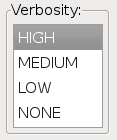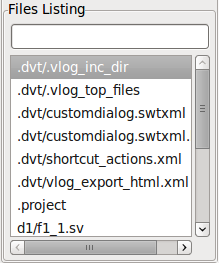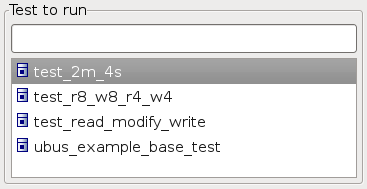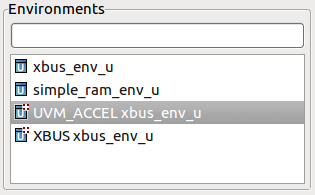SWT/XML Reference
A custom dialog is described in an XML file with .swtxml extension. The first line must declare the file as XML:
<?xml version="1.0" encoding="utf-8"?>
The topmost element must be a Composite widget that defines the title of the dialog (specified by its id attribute) and the widgets that can be used (standard SWT widgets and custom DVT widgets):
<Composite xmlns="http://www.swtxml.com/swt"
xmlns:sv="http://eda.amiq.com/xmlns/customdialog/sv"
xmlns:dvt="http://eda.amiq.com/xmlns/customdialog"
id="Dialog Title">
</Composite>
A widget is a graphical component (e.g. Textbox, Checkbox) or a container of other widgets (e.g. Composite, Group). Each widget has a corresponding XML tag. You can use any widget to create your dialog. If you specify an id attribute for the widget tag, it will also produce an output in the dialog result.
Layouts
There is a large set of layout options available. A complete reference can be found here. The best approach to finding the desired layout is by using the extensive autocomplete provided by the SWT/XML Editor. Below there is a list common use-cases with examples.
Horizonal Fill

<Composite id=" -verbosity " layout="layout:fill;">
<Label text="Verbosity:"/>
<Button id=" HIGH " style="RADIO" text="High"/>
<Button id=" MEDIUM " style="RADIO" text="Medium"/>
<Button id=" LOW " style="RADIO" text="Low"/>
</Composite>
Vertical Fill

<Composite id=" -verbosity " layout="layout:fill;type:VERTICAL;">
<Label text="Verbosity:"/>
<Button id=" HIGH " style="RADIO" text="High"/>
<Button id=" MEDIUM " style="RADIO" text="Medium"/>
<Button id=" LOW " style="RADIO" text="Low"/>
</Composite>
Grid

<Composite id=" -verbosity " layout="layout:grid;numColumns:3;">
<Label text="Verbosity:" layoutData="horizontalSpan:3;"/>
<Button id=" HIGH " style="RADIO" text="High"/>
<Button id=" MEDIUM " style="RADIO" text="Medium"/>
<Button id=" LOW " style="RADIO" text="Low"/>
</Composite>
Widgets
Composite
Composites are used for grouping other elements, and they have no visual representation. You can control how their children elements are arranged by specifying the layout attribute. See the Layouts section for information on how to control the look of the dialog.
Group
Groups are similar to composites, except that they are graphically delimited by a border and can have a title specified by the text attribute. Refer to Radio Button for an example.
Label
Labels are simple text fragments used to present information. Refer to Textbox for an example.
Textbox

XML
<Label text="Seed number:"/>
<Text id=" -seed " style="BORDER" text="123456" />
- Output
-seed 123456
Checkbox

XML
<Button id=" -cov " style="CHECK" text="Collect coverage" selection="true" />
<Button id=" -wave " style="CHECK" text="Dump wave" />
- Output
-cov
Radio Button

XML
<Group id=" -sim " text="Simulator" layout="layout:fill;type:VERTICAL;">
<Button id=" IUS " style="RADIO" text="IUS" selection="true"/>
<Button id=" VCS " style="RADIO" text="VCS" />
<Button id=" Questa " style="RADIO" text="Questa" />
</Group>
- Output:
-sim IUS
Directory Chooser

XML
<dvt:DirectoryChooser
id=" -sim_dir "
question="Sim dir"
layoutData="horizontalAlignment:FILL;"
value="../sim"/>
- Output:
-sim_dir ../sim
File Chooser

XML
<dvt:FileChooser
id=" -mem_file "
question="Memory init data"
layoutData="horizontalAlignment:FILL;"
extensions="*.bin"
value="/common/mem/init.bin"/>
- Output:
-mem_file /common/mem/init.bin
Combo Box

XML
<Combo
id=" -test "
text="test_reset"
items="test_random;test_reset;test_back2back;test_1;test_2;test_3"/>
- Output:
-test test_reset
Combo Box (read only)

XML
<Combo
id=" -test "
style="READ_ONLY"
text="test_reset"
items="test_random;test_reset;test_back2back;test_1;test_2;test_3"/>
- Output:
-test test_reset
List

XML
<List
id=" -verbosity "
selection="HIGH"
style="BORDER|V_SCROLL"
items="HIGH;MEDIUM;LOW;NONE"/>
- Output:
-verbosity HIGH
Directory Files Listing
Lists all files/dirs that match a certain criteria in a specified folder.

XML
<dvt:DirectoryFilesListing
id=" -file "
question="Files Listing"
includePaths="**\*.sv;**\*.e;**\*.vhdl"
excludePaths=""
rootDirectory="/home/path/.."
fileType="FILE;DIR"
outputOption="basename"
showHiddenFiles="true"
timeoutSeconds="10"/>
- Output:
-file file_name
Parameters
- includePaths (excludePaths) - include (exclude) files based on their filename
- Examples
“**\*.e;**\*.vhd” matches all .e and .vhd files/dirs in a directory tree.
“test\a??.sv” matches all files/dirs that start with an ‘a’, then two more characters and then “.sv”, in a directory called test.
“**” matches everything in a directory tree.
“**\test\**\XYZ*” matches all files/dirs that start with “XYZ” and where there is a parent directory called test (e.g. “abc\test\def\ghi\XYZ123”).
Default value for ‘includePaths’ is ‘**’
rootDirectory - can be specified as an absolute path or relative to a project in the current workspace. The path can also contain system variables.
- fileType - select whether files, directories or both are shown
FILE - displays only files
DIR - displays only directories
FILE;DIR - displays both files and directories
Default value for ‘fileType’ is FILE
- outputOption - option to format the selected file’s name
‘basename’ - returns the file’s name without extension
‘fullname’ - returns the file’s name with extension
‘fullpath’ - returns an absolute path of the selected file
‘relativepath’ - a path relative to ‘rootDirectory’
showHiddenFiles - by default is false
timeoutSeconds - if the root directory has a large number of children, listing them is stopped after * seconds
Note
The includePaths and excludePaths attributes use ant-like path patterns.
Class Selector

XML
<sv:ClassSelector
id=" -test "
question="Test to run"
fieldSeparator=","
layoutData="horizontalAlignment:FILL;
verticalAlignment:FILL;
grabExcessHorizontalSpace:true;
grabExcessVerticalSpace:true;"
baseClassName="uvm_test"/>
- Output:
-test test_2m_4s
Note
This widget is only available for SystemVerilog.
Struct selector

XML
<e:StructSelector
id=" -env "
question="Environments"
fieldSeparator=","
layoutData="horizontalAlignment:FILL;
verticalAlignment:FILL;
grabExcessHorizontalSpace:true;
grabExcessVerticalSpace:true;"
baseStructName="uvm_env"
showWhenSubtypes="true"
hierarchyLevels="1"/>
- Output:
-env UVM_ACCEL xbus_env_u
Note
This widget is only available for e Language.
Note
The hierarchyLevels attribute can either be an integer, or all in order to control the displayed inheritance level starting from the when subtypes.